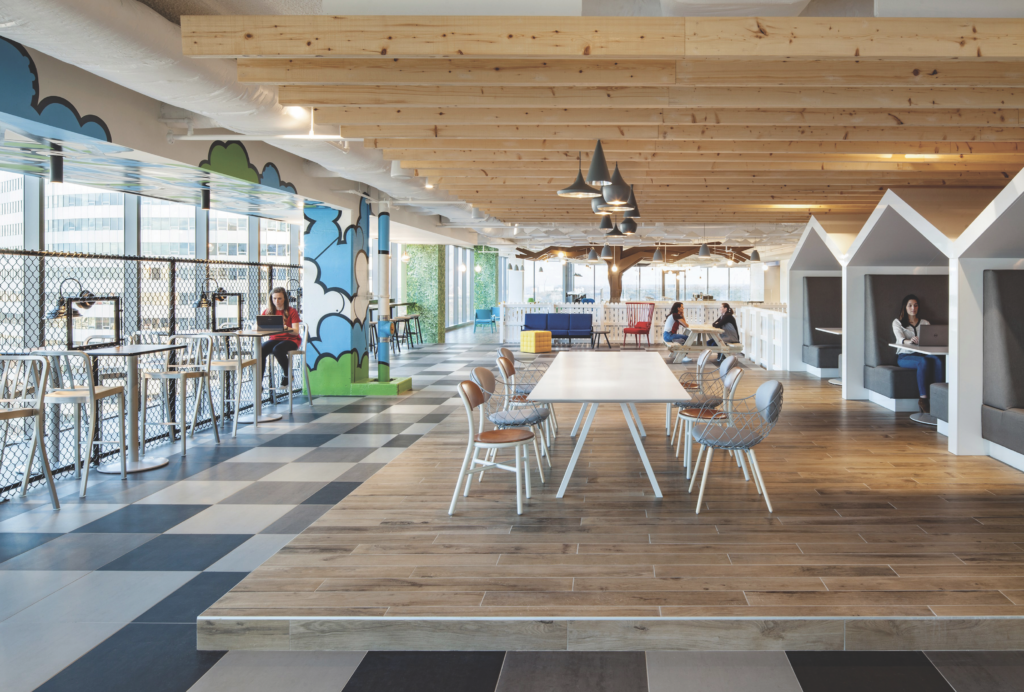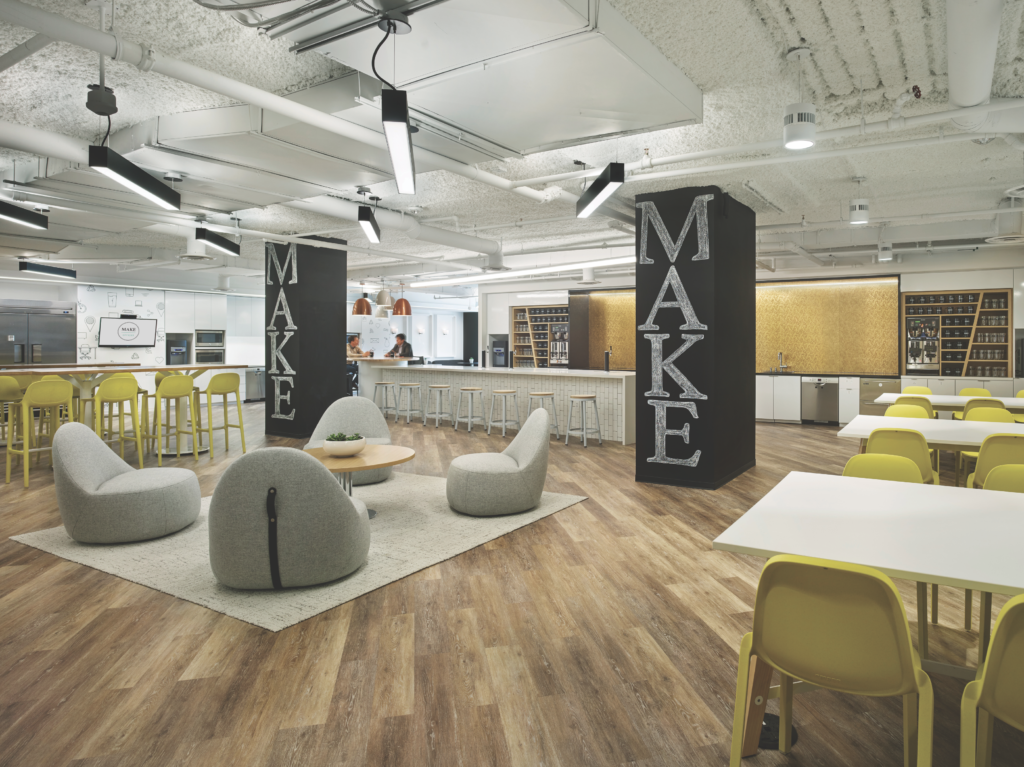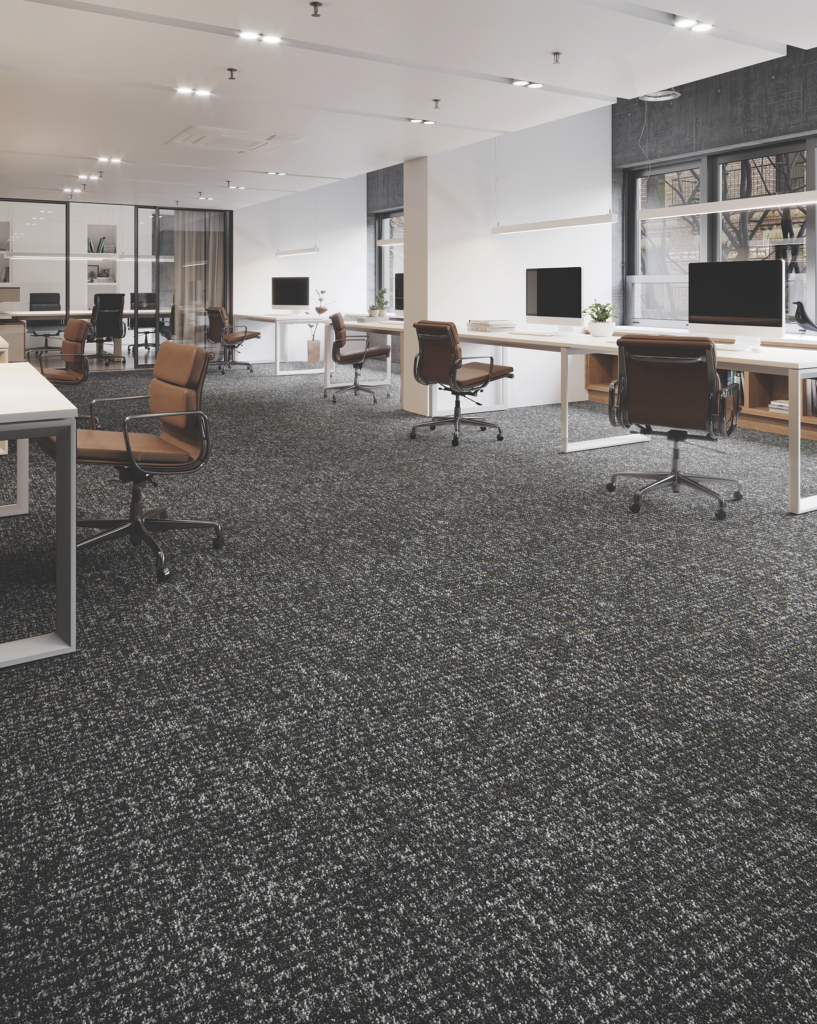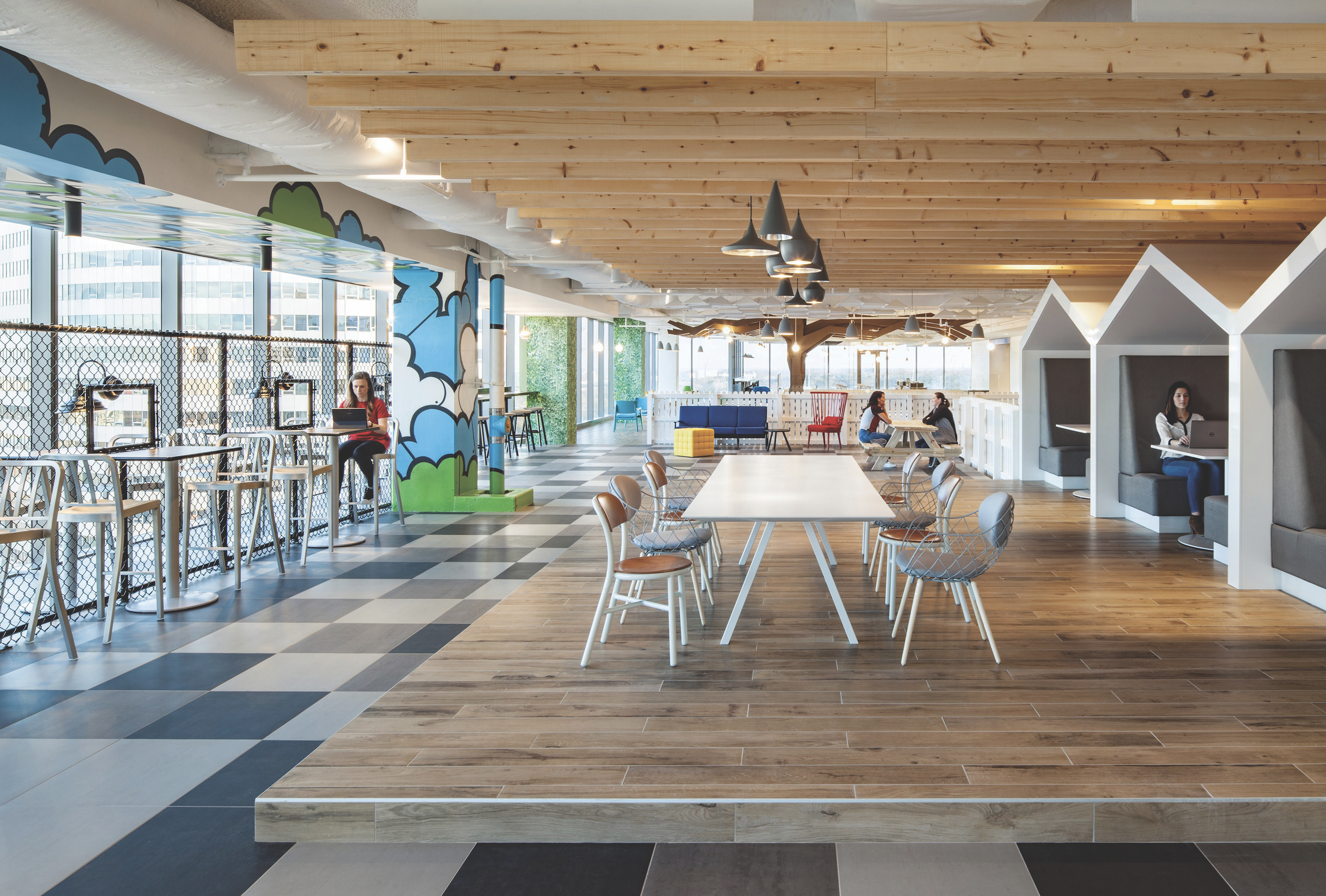
The Stantec-designed Gartner Mid-Atlantic Center of Excellence
in Arlington, Va. (Photo by Ron Blunt)
What it means to design for evolving workplace needs
by K.J. Quinn
“As more employees put in more hours at work, many offices are beginning to offer unique amenities to make employees feel relaxed, comfortable and happy.”
— Kerri Convery
The traditional workspace – often featuring perimeter offices for executives, large boardrooms with sweeping views and cubicles for employees – is a thing of the past. The new workplace is positioned to build community, foster relationships and inspire people to do their best work every day. In fact, a 2018 Capital One study saw 79% of employees surveyed say an innovative office design was essential to innovative thinking.
“As more employees put in more hours at work, many offices are beginning to offer unique amenities to make employees feel relaxed, comfortable and happy,” said Kerri Convery, a spokesperson for Parterre Flooring Systems. “Current trends in office design focus on improving both the functionality and aesthetics of a space, and that pattern will continue into the new year.”
With today’s diverse workforce, employers are also often challenged by competing expectations of five generations of workers. In the war to attract and retain top talent, employees want and expect a great experience at work — spaces with mostly open environments combined with the right amenities and on-demand private spaces. The five top-performing amenities with the greatest impact include innovation hubs, maker spaces, quiet/tech-free zones, outdoor workspaces and focus rooms, according to the 2019 Gensler U.S. Workplace Survey.
“Hospitality-esque furnishings, warm, unassuming finish palettes and loads of accessories are scattered about in a multitude of different collaborative settings,” noted Alana Lopez, director, hospitality and workplace studio at Stantec. “It enables employees to work where they want and how they want with their ‘creature com- forts’ within grasp.”
Indeed, office design trends evolved over the last decade. Whether it was the bean bag fad of the mid to late 2000s or the ever-popular standup desks, designers and companies are always looking for the next trend to retain employees and improve productivity.
“The office space keeps evolving as people bring design thinking and other theories into the workplace to meet the changing needs of teams and the need to collaborate and move in the space,” noted Jeanette Himes, director of design, workplace, retail and TI, Mohawk Group. “It’s becoming clearer that people need a variety of spaces.”
The Modern Office

MakeOffices in Washington, D.C., designed by Gensler. (Photo by Halkin Mason Photography)
The “open office” space that grew in popularity in recent years is reportedly giving way to a combination of public and private areas due to the inability of employees to focus in completely open spaces.
“Employers are finding that while the open office is a great concept for maximizing real estate, it actually has a detrimental effect on productivity,” Stantec’s Lopez said. “With so many distractions and constant interruptions, employees are finding it harder to get their work done in an open setting.”
Designers are attempting to strike a balance that works for certain needs and focusing more intently on “activity needs.” This is leading to the creation of diverse workplaces – with open, enclosed and semi-enclosed collaboration spaces, social settings and focus areas. Offices are in essence being designed to provide maximum flexibility and optimize employees’ performance. “This likely will include formal and informal meeting areas, including space for instant brainstorming,” said Carla Remenschneider, IIDA, director of interior design for Fanning Howey.
While employers are cognizant of workers’ needs to maximize their performance, there are more factors influencing office design from the ground up. For example, most office projects reportedly follow LEED or BREEAM (Building Research Establishment Environmental Assessment Method) certifications that center on the sustainability and environmental performance of buildings. As such, many companies carefully select interior decorating products based on how they impact the environment. “Strategies like active design, mindful materials, circadian lighting design with natural daylight, healthy food options [and] personal thermal comfort options all help in promoting occupant health and wellness and boosting productivity, and thus have a considerable impact on employee costs and talent attraction/retention,” noted Judhajit Chakraborty, senior sustainability consultant/associate at Stantec.
Meanwhile, the movement toward biophilic design continues to gain momentum in the corporate market with many organizations following the tenets of this concept. “[You need] lots of light and views of nature,” said Sherry Dreger, creative strategy leader at Milliken. “Trees and plant life within the office space are adding color, nature and fresh air.”
Within the flooring industry, commitment to material health has become a standard. For instance, Environmental Product Declarations (EPDs) and Health Product Declarations (HFDs) have reportedly helped fine-tune the process of identifying healthy products for commercial interiors. “All of Milliken’s modular carpet products in North America are certified Red List Free with third-party verification in addition to being Cradle to Cradle Certified Silver,” said Meredith Conner, strategic marketing specialist.
While sustainability is a major consideration, equally important is color and design. A case in point is “resi-mercial” – a design trend driven largely by millennials – that applies the comforting elements of residential design to commercial spaces.
Residential warmth is found in finishes that are trending, such as abstract and geometric patterns, a popular look on fabrics and floors in office spaces. “Combining different abstract elements together that can easily be swapped in and out creates a more unique space and gives you more diverse design options,” said Parterre’s Convery.
Flooring's Role

One carpet tile of Milliken’s Major Frequency features two organic patterns available in 17 colors and explores the possibilities of raw, unencumbered cymatics.

Mohawk Group’s Textural Effects carpet collection, shown here in the Matte Finish pattern, features comfort, soft textures and bulky yarns in modular planks and broadloom.
The workplace is among the most diverse segments in terms of flooring choices. Among the key factors impacting the spec are the functional and design needs of a space. For example, “colors and patterns in carpet and LVT provide a form of wayfinding to separate quiet areas from louder ones,” said Fanning Howey’s Remenschneider. “Color and pattern of flooring also have a significant impact on the mood and productivity of employees.”
Textile visuals are trending on office floors, an area that impacts everything from the level of employee motivation to efficient workflow and recruitment. “Wood aesthetics still give a sense of warmth,” Mohawk’s Himes pointed out. “But in the workplace, designers are excited to try new offerings to give people a variety of choices where they want to work.”
Carpet tile is the most popular choice, thanks in part to evolving aesthetics and formats that are helping the product expand into workstations, board rooms and privacy rooms. Broadloom remains a favorite in speculative workspaces or “market-ready” offices looking for cost effective, upfront investments. “You see broadloom in high-end areas such as conference rooms,” Mohawk’s Himes noted. “Sometimes it’s in offices adjacent to open areas where you might use tile and, of course, on stairs.”
Hard surfaces such as resilient, hard- wood, porcelain tile and polished concrete are preferred for certain parts of the office where fashion and functionality are required. LVT is the fastest growing hard surface, reportedly gaining coverage in reception areas, workrooms, kitchens, din- ing areas as well as corridors, thanks to its strong performance qualities and wide selection of natural-looking aesthetics.
“We are seeing a trend towards more hospitality-like finishes, including LVT or laminate flooring, polished concrete, specialty decorative tile – all items to bring personality and warmth to the previously sterile workplace,” Stantec’s Lopez said.
In addition, workplace noise is repeatedly tied to reduced productivity and performance. Many office products such as flooring are designed for sound reduction. “Sustainable flooring, such as rubber, has better acoustics and is more comfortable for employees working long hours,” noted Fanning Howey’s Remenschneider.
Looking ahead, talent competition, emerging technologies, the experience economy and growing business and employee/client demands are driving the evolution of the workplace. As new technologies rapidly emerge, workspaces must function comfortably in beta mode to account for disruption, allow for adaptation and encourage new ways of working.
To see this story in print:
